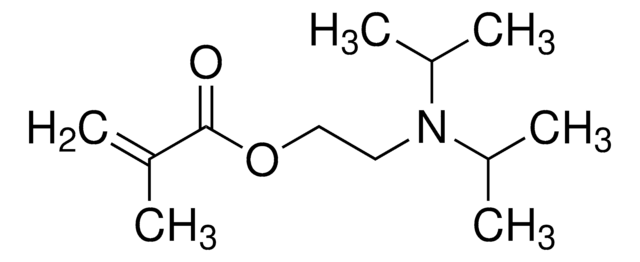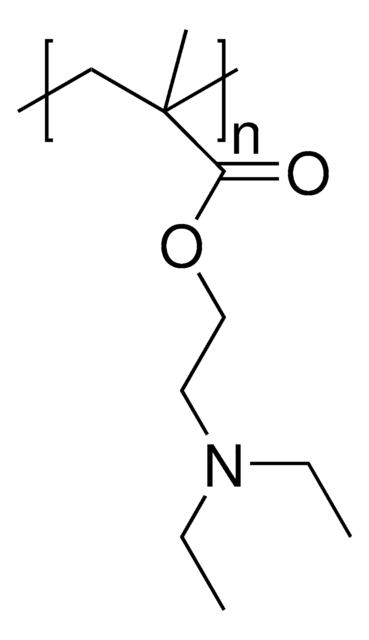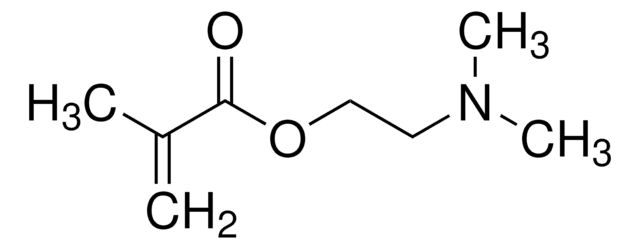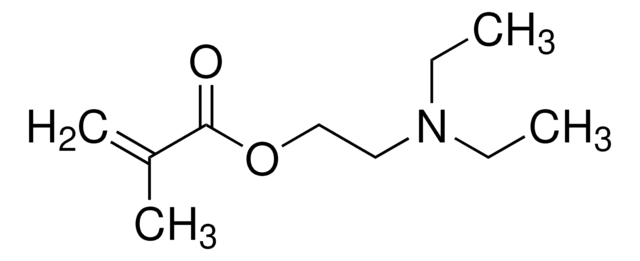910457
Poly(2-(diisopropylamino)ethyl methacrylate)
average Mn 10,000
Synonym(s):
Hydrophilic, PDPA, pH sensitive, pH-responsive
Sign Into View Organizational & Contract Pricing
All Photos(1)
About This Item
Linear Formula:
(C12H23NO2)n
UNSPSC Code:
12162002
NACRES:
NA.23
Recommended Products
form
powder or solid
mol wt
average Mn 10,000 (by NMR)
average Mn 10,000
color
white to faint yellow
PDI
≤1.3 (by GPC)
storage temp.
2-8°C
Application
Poly(2-(diisopropylamino)ethyl methacrylate) is a pH-responsvie polymer. pH-Responsive polymers are a group of stimuli-responsive polymers that can respond to solution pH by undergoing structural and property changes such as surface activity, chain conformation, solubility, and configuration. The term “pH-responsive polymers” is commonly used to describe polymers having ionisable acidic or basic residues whose ionization depends on solution pH. The physical properties of the polymer, such as its chain conformation, configuration, and solubility, can be tailored by manipulating the pH or ionic strength. These unique properties of pH responsive polymer systems consequently make them very useful in various applications such as drug delivery, gene delivery, sensors, surfaces, membranes, and chromatography.
pH-sensitive polymer systems combined with nanotechnology could be utilized as an alternative strategy to traditional targeting systems to overcome major problems in current chemotherapy represented by non-specific tissue distribution of the drugs, tumor heterogeneity, and multidrug resistance (MDR) against anticancer drugs.
pH-sensitive polymer systems combined with nanotechnology could be utilized as an alternative strategy to traditional targeting systems to overcome major problems in current chemotherapy represented by non-specific tissue distribution of the drugs, tumor heterogeneity, and multidrug resistance (MDR) against anticancer drugs.
Storage Class Code
11 - Combustible Solids
WGK
WGK 3
Flash Point(F)
Not applicable
Flash Point(C)
Not applicable
Choose from one of the most recent versions:
Certificates of Analysis (COA)
Lot/Batch Number
Sorry, we don't have COAs for this product available online at this time.
If you need assistance, please contact Customer Support.
Already Own This Product?
Find documentation for the products that you have recently purchased in the Document Library.
pH-Responsive polymers
Kocak G, et al.
Polym. Chem., 8, 144-176 (2017)
pH-sensitive polymers for drug delivery.
Huh K M, et al.
Macromolecular Research, 20(3), 224-233 (2012)
Jing Xie et al.
Macromolecular rapid communications, 38(23), 1499-1499 (2017-10-05)
Since diabetes mellitus has become one of the most serious threats to human health, researchers have been designing new drugs and developing new technologies to control the blood glucose level (BGL) while improving patient compliance. In addition to the traditional
Hong-ming Ding et al.
Scientific reports, 3, 2804-2804 (2013-10-01)
The major challenge in cancer therapy is to efficiently translocate drug molecules into cancer tumors without doing any damage to healthy tissues. Since there exist pH gradients between tumor and normal tissues, pH-sensitive materials may have great potential to overcome
Prithankar Pramanik et al.
Macromolecular rapid communications, 37(18), 1499-1506 (2016-07-23)
The synthesis, micellar aggregation, and pH-triggered intracellular drug delivery ability of an amphiphilic statistical copolymer (P2) are studied. Two methacrylate derivatives, one containing a hydrophilic pendant and the other containing a hydrophobic pendant chain, are copolymerized to produce P2. The
Our team of scientists has experience in all areas of research including Life Science, Material Science, Chemical Synthesis, Chromatography, Analytical and many others.
Contact Technical Service




![N-[3-(Dimethylamino)propyl]methacrylamide 99%, contains MEHQ as inhibitor](/deepweb/assets/sigmaaldrich/product/structures/295/145/6b4aae15-7cb5-4b7b-9c06-8e6d24e50951/640/6b4aae15-7cb5-4b7b-9c06-8e6d24e50951.png)



![[2-(Methacryloyloxy)ethyl]trimethylammonium chloride solution 75 wt. % in H2O](/deepweb/assets/sigmaaldrich/product/structures/316/612/66b0f4cf-d060-427d-b4f5-e8fab3e5cffe/640/66b0f4cf-d060-427d-b4f5-e8fab3e5cffe.png)